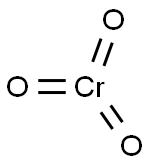Chrormic trioxide , AR,99% , 1333-82-0
Synonym(s):
Chromic anhydride;Chromic anhydride, Chromium trioxide;Chromium(VI) oxide
CAS NO.:1333-82-0
Empirical Formula: CrO3
Molecular Weight: 99.99
MDL number: MFCD00010952
EINECS: 215-607-8
PRODUCT Properties
| Melting point: | 196 °C (dec.)(lit.) |
||||||||||||||
| Boiling point: | 330 °C |
||||||||||||||
| Density | 2.7 |
||||||||||||||
| bulk density | 900kg/m3 |
||||||||||||||
| vapor pressure | 0Pa at 25℃ |
||||||||||||||
| Flash point: | 250°C |
||||||||||||||
| storage temp. | Store below +30°C. |
||||||||||||||
| solubility | 1.667g/l |
||||||||||||||
| form | macroporous |
||||||||||||||
| pka | -0.61[at 20 ℃] |
||||||||||||||
| Specific Gravity | 2.7 |
||||||||||||||
| color | Reddish-violet |
||||||||||||||
| PH | <1 (100g/l, H2O, 20℃) |
||||||||||||||
| Water Solubility | Highly soluble |
||||||||||||||
| FreezingPoint | 170~172℃ |
||||||||||||||
| Sensitive | Hygroscopic |
||||||||||||||
| Merck | 14,2235 |
||||||||||||||
| crystal system | Nogata |
||||||||||||||
| Space group | Ama2 |
||||||||||||||
| Lattice constant |
|
||||||||||||||
| Exposure limits | ACGIH: TWA 0.0002 mg/m3; STEL 0.0005 mg/m3 (Skin) OSHA: Ceiling 0.1 mg/m3 NIOSH: IDLH 15 mg/m3; TWA 0.0002 mg/m3 |
||||||||||||||
| Stability: | Stable. Strong oxidizer. Reacts with most organic material in a violent and often explosive fashion. Moisture sensitive. |
||||||||||||||
| InChIKey | WGLPBDUCMAPZCE-UHFFFAOYSA-N |
||||||||||||||
| CAS DataBase Reference | 1333-82-0(CAS DataBase Reference) |
||||||||||||||
| NIST Chemistry Reference | Chromium trioxide(1333-82-0) |
||||||||||||||
| EPA Substance Registry System | Chromium(VI) trioxide (1333-82-0) |
Description and Uses
Chromium hydroxide (Cr2O(OH)4) is a bright bluish-green pigment prepared by the calcinations of bichromate with boric acid at 500°C. The mass during cooling is hydrolyzed with water, which yields the hydrate.
Chromium(VI) oxide is widely used in chromium electroplating, and as protective coatings in corrosion/oxidation resistance of metals. It is also employed in CDs and DVDs. It is useful as an oxidant in Jones oxidation in acetic acid or acetone. It is used in the oxidation of primary alcohols into carboxylic acids, and secondary alcohols into ketones. With phosphoric acid, it is used as a stripping agent for anodic coatings of all types and in the production of syntheric rubies.
Safety
| Symbol(GHS) |      GHS03,GHS05,GHS06,GHS08,GHS09 |
| Signal word | Danger |
| Hazard statements | H271-H301+H311-H314-H317-H330-H334-H335-H340-H350-H361f-H372-H410 |
| Precautionary statements | P210-P260-P280-P303+P361+P353-P304+P340+P310-P305+P351+P338 |
| Hazard Codes | O,T+,N,T |
| Risk Statements | 45-46-9-24/25-26-35-42/43-48/23-50/53-62-8 |
| Safety Statements | 53-45-60-61-36/37/39-28-26-22 |
| RIDADR | UN 1463 5.1/PG 2 |
| OEB | E |
| OEL | TWA: 0.0002 mg/m3 (8-hours) |
| WGK Germany | 3 |
| RTECS | GB6650000 |
| TSCA | Yes |
| HazardClass | 5.1 |
| PackingGroup | II |
| HS Code | 28191000 |
| Hazardous Substances Data | 1333-82-0(Hazardous Substances Data) |
| Toxicity | LD50 oral (rat) 80 mg/kg PEL (OSHA) 0.1 mg (CrO3)/m3 (ceiling) TLV-TWA (ACGIH) 0.05 mg (Cr)/m3 |
| IDLA | 15 mg Cr(VI)/m3 |


